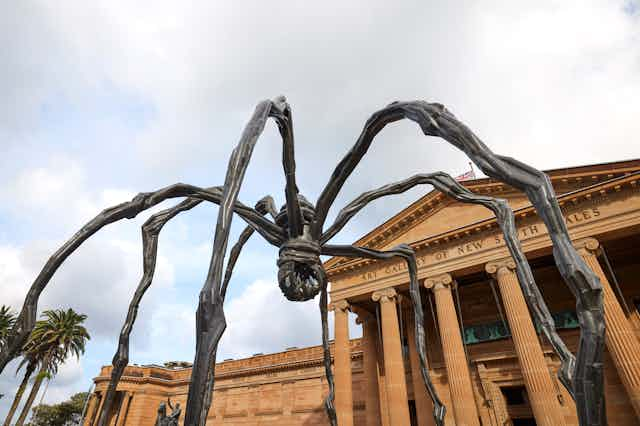As you make your way towards the Art Gallery of New South Wales, you will come across the giant sinewy bronze legs of the artist’s monumental sculpture Maman (“mum” in French) looming near the entrance.
As large to us as humans appear to spiders, Maman borrows the form of a daddy longlegs, but through its title switches both parent and gender. The artist replaces our fear of spiders with the love and protection associated with motherhood.
Despite a life and career mostly spent in New York City, where she moved in 1938 and remained until her death in 2010, the artist, born and educated in France, insisted on her “right to defend her Frenglish”. Titles of her works and her extensive body of writings move seamlessly from her native tongue to English to a deeply personal intermixing of both languages.
London’s Tate acquired the original Maman in 2008, but six other versions also exist. One now stands in the Domain, marking the arrival of Louise Bourgeois in Sydney and the opening of the first large scale show in the new Sydney Modern.
First opened to the public just over a year ago, the Sydney Modern promised “a 21st-century gallery providing one of the world’s great art museum experiences”. This exhibition matches this ambition with a deeply thoughtful and sensuous show.
In the night

Bourgeois’s career as an artist started in the late 1930s in France. In the first three decades of her life in New York City, Bourgeois pursued her artistic practice – drawing, painting, etching, sculpting, writing – while raising her three children.
In 1976, one of her Femme Maison paintings (a literal translation of housewife in French) was reproduced on the cover of Lucy Lippard’s From the Center: Feminist Essays on Women’s Art.
Bourgeois’s work gained a wider recognition through its association with feminist art, and in 1982, at the age of 71, she was introduced to a global audience with a retrospective at New York’s Museum of Modern Art.

She continued to produce new works throughout her life, until her death at the age of 98. Her oeuvre has been shown across the world, including blockbuster exhibitions at the Pompidou Centre, the Guggenheim and the Hayward Gallery.
Now in Sydney, Bourgeois’s groundbreaking and masterful art is clearly celebrated, but room is also made for fresh discoveries.
Downstairs in the Tank is her phallus-shaped sculpture Fillette Sweeter version (1968–1999). A hanging sculpture about half a metre tall, made of latex over plaster, it relates to a larger group of sculptures the artist conceived in the 1960s that concern the human body.

Like her Janus sculptures (1968), also in the Tank, it plays on the ambivalence of sexual identity and manages to represent both female and male anatomy in a single form. Both Fillette and Janus hover delicately above the ground, their fragility and gender-bending ambiguity highlighted by the vastness and semi-obscurity of the room in which they hang.
Exquisite lighting and sound effects give viewers a rarely experienced intimacy with the works on display.
As we find our bearings in relative darkness, sculptures and installations suddenly appear, as if for our eyes only. Upon approaching the works, we suddenly perceive reflected shadows that often merge with our own. A cat is hiding in one corner; a spider is just above us.

In the middle of the Tank a giant mirror, Has the Day Invaded the Night or the Night Invaded the Day? (2007), returns our gaze, and a projected moving image of the artist can be seen on one of the walls. As you come closer, the sound of the artist’s voice lands directly into your ears.
In the day
Upstairs, in the “day” section, the exhibition is more straightforward, but it offers welcome context and contrast to the sensory immersion of the underground.
Bourgeois famously declared “everything I do was inspired by my early life”. The exhibition provides the context of the complexities of the artist’s life and emotions, and how they relate to her body of work.
The 2007 Ode à la Bièvre, a fabric illustrated book, is an homage to the Bièvre river, for centuries Paris’s second waterway which sustained many industries, including her family’s tapestry repair business. The Bièvre and the spider are related to Bourgeois’s mother, a skilled weaver who died when the artist was a young adult.

Ode à la Bièvre captures written evocations of her childhood gardens and its fruit trees. Pearls and buttons are stitched onto delicate handkerchiefs in Eugénie Grandet (2009), a reference to a novel by French 19th-century writer Honoré de Balzac.
In the tiny but gorgeous Topiary IV (1999), the tree trunk is a human body covered in a delicate lace garment and propped up on a clutch. The figure is missing a leg, and it evokes both an homage to the artist’s older sister, Henriette, who had a physical disability, and Bourgeois’s oft evoked memory of wounded soldiers coming back home from the first world war fronts.
References to French language and the cultural landscape it carries abound in the exhibition and in her oeuvre. They can be seen in the titles of works, in the writings that feature abundantly inside and alongside Bourgeois’s artworks, and they can be heard in the Gallic accentuations of her voice.
This presence of French fuels the autobiographical nature of her art but also participates in its lasting cross-cultural appeal.

Just like Fillette, Bourgeois’s oeuvre magically hangs in a suspended state of translation and transformation, reshaping personal memories into forms and words that we can all understand and relate to in the end.
Louise Bourgeois: Has the Day Invaded the Night or Has the Night Invaded the Day? is at the Art Gallery of New South Wales until April 28 2024.
Read more: If I could go anywhere: I'd revisit Maman, Louise Bourgeois' 9-metre spider at London's Tate Modern

